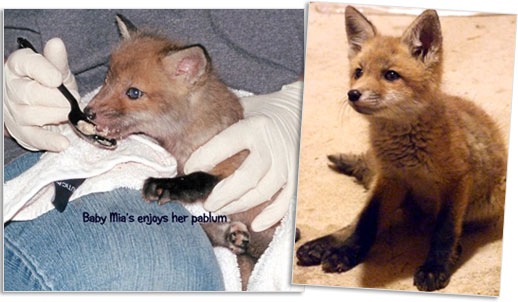Fox, Fox, and More Fox
Dear fox, if you have mange you are welcome at the Center. We can get you back to your hairy, healthy selves.
video: The family who brought Noel to the Center shared the video of her release back into the wild.
In late April, our first little female fox arrived. She was caught in a window well under a porch. Associated Humane Society in Newark went out on the rescue and brought the tiny kit to Wild Baby Rescue Center. She was about 7 weeks old, scared and dehydrated. She was put in a warm crate, and given food and formula. We named her Aurora.

Baby Mia enjoys her pablum
Next to be admitted was a 6 week old kit we named Mia. She was found on the side of the road and it is suspected that she had been hit or bumped by a car. Although the x-rays were negative, for the first week she refused to walk. We held her and hand fed her to ensure she was getting enough nourishment to help her heal. She would just sit beside us when we cleaned her cage. We were not sure she would ever walk. One day she was placed on the floor for cage cleaning and she followed us around the room. Sometimes all an animal needs is a little time and supportive care.
Now that little Mia was well and out of quarantine we introduced the little girls. You would think they had always been sisters. It was amazing to watch them play tag and chase. These girls needed each other to become little fox.

Photos: (top to bottom) Cinderella upon admission, Cinderella fully healed, Bob on admission, Bob with three weeks of care.
The third little female we named Cinderella. She was admitted with only two little tuffs of fur left on her body, so sick with mange. Four weeks into her care we found she had broken her leg and required several more weeks of small cage rest. Finally 9 weeks later healthy and ready for “the Ball” she was re-released back to her mother and siblings.
The forth female admitted, also with mange, was little Noel. She was released back to her family and den on New Year’s Eve (see video above). Little Noel spent extra time at Wild Baby Rescue putting on enough weight for the cold winter months ahead.
The last fox is an older male named Bob. He was probably about 24 hours away from death. Luckily his rescuer cared enough to go to great lengths to trap him and get him here for help. He was emaciated and dehydrated, with little fur and many open wounds. Three treatments later, he is gaining weight, his wounds are healing and new fur is beginning to grow. Depending on the weather, Bob will be released in February or March 2011.
A Word About Mange
Mange is a very treatable condition caused by a tiny mite that infects the animal under its skin. The animal develops sores from scratching, hair loss and becomes dehydrated and emaciated. The animal itches so much, he doesn’t hunt. The cycle goes around and becomes sicker and eventually succumbs to a horrible, slow death. Wild Baby Rescue Center treats mange (especially in Fox) very successfully. If you see an animal that looks like Cinderella or Bob’s before pictures (on the right) please call us at (908) 362-9453.
